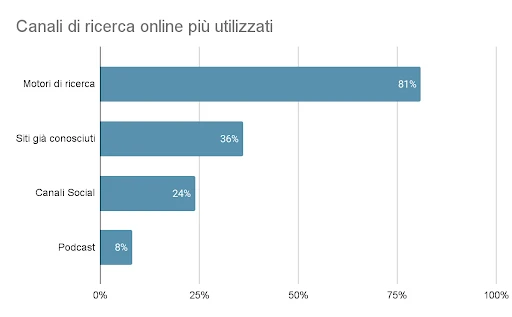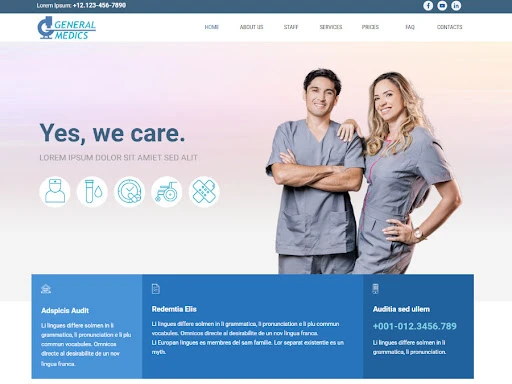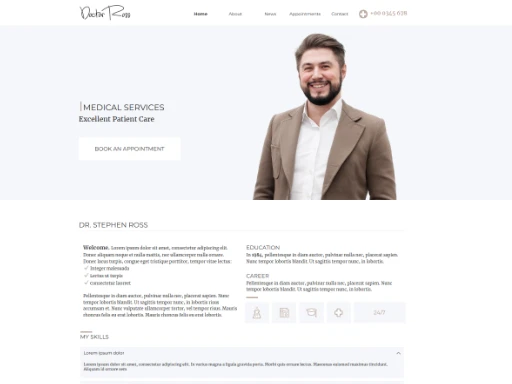Physician Websites: Complete Guide
Published by Incomedia in Guides and Tips · Monday 20 Mar 2023
Do you know him? They call him "Doctor Google". He's available 24 hours a day every day of the year and always seems to have an answer for any issues or questions regarding our health.






Of course you know him! If, like me, you're not a doctor, you've certainly already done more than one search to find a specialist, discover a remedy or understand more about a certain disorder.
If, on the other hand, you are a doctor, you probably view Dr. Google with a certain amount of suspicion. In reality, he could be a valuable ally for you and, in this article, we'll attempt to understand why.
Health: 1 out of 2 people educate themselves online
Let's start with the data. Presented in May '22 by the IPSOS Institute, it was one of several studies confirming that researching information on health continues to increase steadily. In the 12 months considered, 85% of Italians educated themselves on health and prevention and, of these, 51% chose to do so by searching for information on the internet (percentage consistent across all age groups).
But what is the most sought-after information on the internet? The top 5 are as follows:

Since 1 out of 2 Italians search for health information on the internet, which are the most used and considered the most reliable channels? The same IPSOS research tells us the following:

And they're all growing statistics compared to what was seen in 2020 alone.
The fact that people increasingly trust the information they find online is also demonstrated by another important fact. 83% of users say they follow online influencers or experts in the field of health (in most cases, doctors and pharmacists).
The same IPSOS study, however, also tells us that the internet alone is not enough. After getting information online, in fact, 57% of people go back to their doctor or go to the pharmacist (33%) to investigate further and make their decisions.
So, in the end, although it's steadily increasing, the online universe doesn't replace the more traditional offline channels. What we are witnessing, rather, is an increasingly close integration of the two areas. People are very sensitive to the issue of health and well-being and attempt to get information online but then turn to professionals for a more definitive opinion.
Why create a physician website?
Understanding these dynamics is essential for those who work in the healthcare industry. Institutions, companies, doctors and healthcare professionals cannot underestimate the fact that people are moving online with increasing confidence and familiarity.

Do we need a physiotherapist? Have we been referred to a dermatologist? Did they tell us about a particular clinic where we can get a general assessment? First, let's check online. We probably won't stop there, but doing a search costs nothing, and if we can learn more, we'll be pretty happy. If, on the other hand, we don't find anything, we'll be disappointed and, most likely, we'll tend to score one less point for the "candidate" we were evaluating.
So here's why for a doctor (as well as for anyone else working in the healthcare field) it's so important to have an online presence. The internet provides an opportunity to be discovered and, above all, to be recognized as an authentic, competent and professionally trustworthy.
But how does a doctor build an online presence? That's what we'll now take a look at.
The advantages of physician websites
It may seem trivial, but the starting point for a doctor looking to build an online presence is having their own website.
With a website, in fact, you can intercept searches made by users, present yourself as a serious and reliable professional, share accurate information and acquire new patients.

Going into a bit more detail, the main advantages for a doctor with his own website can be summarized as follows:
- Greater online visibility: Patients can more easily find a doctor and learn about the services he or she offers.
- Better communication: A website is an effective communication channel for informing patients on the latest news, hours of operation, rates and more. This allows you to reduce the time spent communicating directly with patients.
- Relationships with patients: By providing valuable health information and advice through a website, a doctor builds and maintains a relationship of trust with patients.
- Time savings: A website can be used for managing appointments and reservations online, thus reducing the time spent on the phone or at the reception desk.
- Accessibility: A website is available 24/7, allowing patients to access necessary information at any time.
- Better reputation: Ultimately, a professional website helps improve a doctor's reputation and patients' perceptions of his or her professionalism.
Creating websites for doctors and medical practices
Having clarified the reasons why a doctor (or anyone else working in the healthcare field) should have their own website, all that remains is to understand which features it should offer in order for it to be effective.
Creating a successful physician website involves several factors that need to be taken into consideration. The main ones include:
A well-thought-out design can make a big difference by improving patients' perceptions of the doctor and their services offered, thus improving their online reputation.
This is why it's important for a physician website to have a simple and elegant graphic style that's capable of conveying professionalism, reliability and seriousness. In order to obtain this result, the following elements should be considered:
- Colors: The psychology of color tells us that colors have the power to convey emotions and meaning. Specifically, cool, neutral colors like blue, green and gray can be used to create an image of professionalism. Warm colors like red and orange, on the other hand, are perfect for drawing attention to services.
 You can create the color palette for a physician website with a tool like Adobe Color
You can create the color palette for a physician website with a tool like Adobe Color - Font: The font used must be easily readable and in line with the general style of the website. It's important to avoid fonts that are too elaborate or difficult to read as well ensuring that they're always large enough, even for older users and especially when browsing on mobile devices.
- Template: For a physician website, you should choose a simple and clean template with a clear layout to facilitate navigation. The goal is to help patients easily find the information they need, thus reducing the risk of frustration and/or abandonment of the site.
 With a template, you can quickly create a professional physician website
With a template, you can quickly create a professional physician website - Headers and Logos: The medical logo and website header must be clear, legible and recognizable. It must indicate the name of the doctor, their professional title and, if applicable, the logo of the clinic or institution for which he or she works
- Images and Icons: To convey a professional and reassuring image, you should carefully select the images used on the website. Patients have an easier time trusting when they can put a face to the doctor. For this reason, it's best to use real photographs which portray the doctor in a natural work setting. For more standard or decorative content, however, you can use stock images and icons. The important thing is that they're always high quality.
 Focus on quality and real photos: It's the first step in establishing a good doctor-patient relationship.
Focus on quality and real photos: It's the first step in establishing a good doctor-patient relationship.
Structure and content
A physician website must not only look neat and professional, it must have the ability to provide useful information to patients and be organized in such a way that it's easy to find and view.
Though it may depend on the specific needs of each doctor, there are sections and types of content that should always be included:
- Home Page: This is the main page of the website and the first point of contact with visitors. It should be eye-catching and contain important information, including the doctor's name, specialty, services offered and contact information.
- About Us: Here, the doctor can introduce him or herself by providing information on his or her credentials, including training, experience and specializations.
- Services: This is the section that should describe the services offered by the doctor, including treatments and therapies available.
- Contact Info: The office address, telephone number(s) and email address should be included here.
- Privacy Policy: Describe how the physician or facility processes and protects patients' personal information.
These are the necessary pages, but there are other sections and types of content which, if present, contribute to making the site even more effective:
- Online Reservations: Adding an online booking system can make life easier for patients, allowing them to book a doctor's appointment quickly and easily.
- Blogs: These can provide useful information to patients and help position the physician as an expert in his or her specialty.
- FAQs: These serve to provide answers to the questions most frequently asked by patients regarding the services offered, methods of payment and types of medical insurance accepted, etc.
- Patient Testimonials: These are fundamental in building the doctor's reputation and in generating trust among new patients.
- Social Media Links: Social media profiles are an excellent way for a doctor to connect with patients and promote their work.
Regardless of the sections that you decide to include (or not include) on the site, you should remember that all content must then be kept up to date over time in order to consistently guarantee accurate and punctual service.
Responsive design
According to a 2021 study by Statista, 54.8% of global web traffic comes from mobile devices. This means that if a doctor's website is non-responsive, users may find it difficult to navigate and decide to abandon it in favor of another one that's easier to use.
Ensuring that a website is responsive and automatically adapts to the screen size of the device used for navigation should therefore be one of the primary objectives for a good website. By the way, the fact that a site is responsive also has other non-negligible benefits:
- Improving the user experience
- Improving your positioning on search engines
- Improving the doctor's reputation by demonstrating how committed he or she is to patient satisfaction
SEO optimization
Since, as we mentioned at the beginning of the article, at least 1 out of 2 people conduct online research related to health and well-being, when creating a physician website, special attention must be paid to SEO optimization, so it can successfully intercept a large portion of the queries and occupy a high position on search engine results pages.
Surely, you can start with basic optimizations such as selecting the keywords to implement, using header and description tags correctly, offering quality content, creating an intuitive navigation structure and, as we have seen, optimizing for mobile navigation.
In addition to all this, there are also specific actions that need to be implemented for a physician website. These are actions that generally fall under the category of “Local SEO”.
Most likely, the first and most important is to open an account on Google My Business, so the doctor or practice can be found by patients in that geographical area.
Let's look at an example. If a patient needs a pediatrician, they'll tend to narrow the field by looking for one nearby. They'll open Google and type "Pediatrician in Turin" or "Pediatrician near me".
Having a profile on Google My Business will allow the doctor to intercept these kinds of searches.

In the Google My Business tab of the pediatrician's website, the patient will be able to see reviews from other patients, services offered, hours of operation, whether the doctor makes home visits, photos of the office, blogs etc.
The great thing about this Google service is that it's free and easy to activate and update.
Physician websites: Between ethics and Google YMYL
The reasons doctors decide not to create their own websites often stem from legal concerns. In fact, there are legal requirements that you need to be aware of. In reality, though, they're not that difficult to comply with.
First, it's important to remember that on their websites, doctors, in addition to the usual information such as name, office address and email address, must also provide the details of their profession, including:
- Registration with the Order of Doctors, degree obtained and, if applicable, medical specializations
- Country in which medical training was completed
There are also a number of prohibitions you need to be aware of:
- Descriptions of the services offered must not be formulated in a way that's misleading, self-promoting or promising success. You need to provide objective information
- No form of advertising is permitted
- Text on pathologies must be written in an exhaustive manner
- The site must not aim to increase the doctor's popularity
- The goal of the site should not be direct selling
- Feedback systems or guest books can be used but must not be misused
As you can well understand, the goal is for the doctor to provide truthful, correct and unambiguous communication and this, in reality, is important not only from a legal standpoint but also for Google.
Since medical content can have a direct impact on people's health and well-being, Google classifies doctors' websites into the YMYL category (Your Money or Your Life) and requires that, in order to be well positioned, they meet more stringent quality standards.
For example, YMYL pages must be written by medical experts who have the experience and skills necessary to provide accurate and reliable information, and the sources cited must be equally authoritative.
Additionally, YMYL pages must provide complete and relevant information with a clear structure and organized content. Finally, they must ensure that the privacy and security of users' personal information is respected.
Ultimately in producing quality content, physician sites satisfy everyone: the law, Google and, above all, the end users.
WebSite X5: The right tool
So, we've clarified the many ways in which a website can be useful for a doctor, and we've resolved any ethical/legal issues, so what would still stop them from creating their online page?
Perhaps the fear of not having the time or the necessary skills to do it. This is where choosing the right tool comes into play. With software like Website X5, creating a website is not only easy - even for those without graphic or programming skills - it's also quick.

Discover WebSite X5 templates that can help you create sites for medical offices and doctors.
Starting from a template and, working in an entirely visual manner, you can customize any element in order to obtain unique and original results and insert your own content. You can rely on a rich gallery of images and all the features necessary for adding whatever you need in order to create a complete and professional site, including galleries, contact forms, protected login areas, blogs, FAQ and privacy info, etc.
The solution also includes a hosting service with an automatic domain and free webspace for one year.
In no time, your website will be online and ready to field requests from old and new patients.

